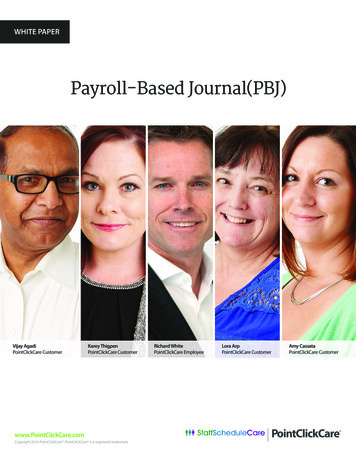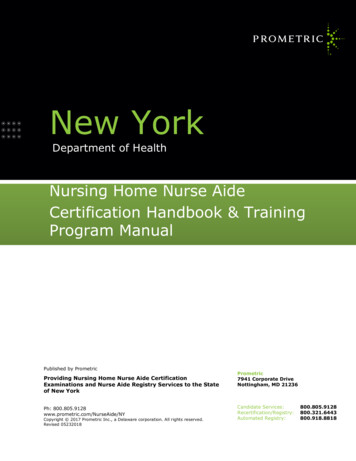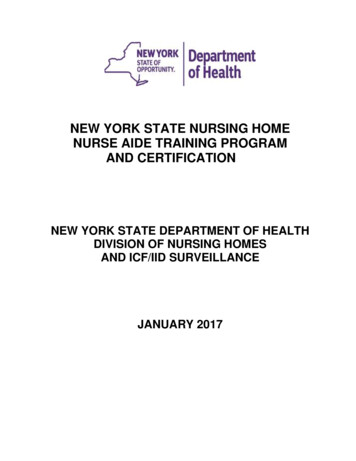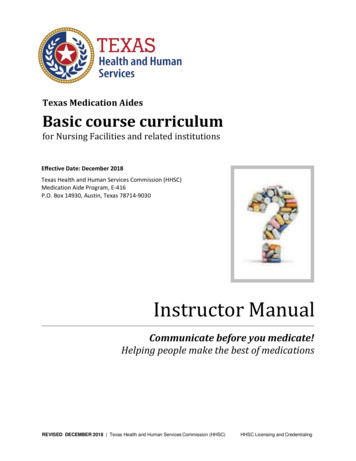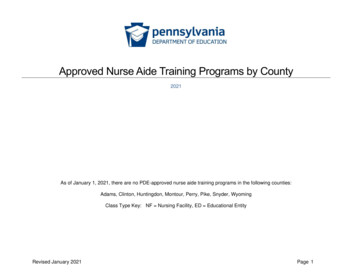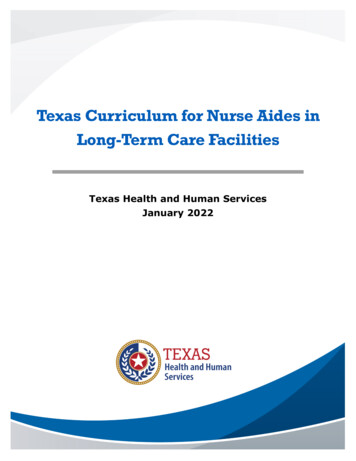
Transcription
Texas Curriculum for Nurse Aides inLong-Term Care FacilitiesTexas Health and Human ServicesJanuary 2022
Table of ContentsCourse Objectives . 31. Course Outline . 41.1 Introduction to Long-term Care . 41.2 Personal Care Skills . 531.3 Basic Nursing Skills . 701.4 Restorative Services . 851.5 Mental Health and Social Service Needs . 921.6 Social Skills . 1172. Procedural Guidelines. 124Beginning Steps: . 124Closing Steps: . 124Observe for, Report and Document to Nurse . 1252.1 Safety and Emergency . 1252.2 Infection Control . 1352.3 Communication . 1412.4 Nutrition and Hydration . 1462.5 Resident’s Environment . 1492.6 Basic Nursing Skills . 1532.7 Personal Care . 1602.8 Elimination Care . 1822.9 Caring for Resident Death . 1902.10 Basic Restoration Services . 1912.11 Prevention of Pressure Ulcers . 1983. Prometric Skills . 2053.1 Prometric Clinical Skills List . 205Appendix A. Guidelines for Using the Texas Curriculum forNurse Aides in Long-Term Care Facilities . A-1Appendix B. Texas Nurse Aide Performance Record . B-1Appendix C. Nurse Aide Training Program Daily Sign-in Record . C-1Appendix D. Texas Administrative Code . D-1Appendix E. Glossary of Terms .E-1Appendix F. Reference Page . F-1ii
Course ObjectivesTo prepare nurse aides with the knowledge, skills and abilities essential for theprovision of basic care to residents in long-term care facilities. After completing thiscourse, participants will be able to: provide person-centered basic care to residents of long-term care facilities. communicate and interact therapeutically with residents and their families,with sensitivity to the physical, social, and mental needs of residents. assist residents in attaining and maintaining maximum functionalindependence. protect, support and promote the rights of residents. provide safety and preventive measures in the care of residents. demonstrate skill in observing, reporting and documentation. function effectively as a member of the health care team.3Revised: 1/2022
1. Course Outline1.1 Introduction to Long-term CareKey TermsAbuse - the willful infliction of injury, unreasonable confinement, intimidation orpunishment with resulting physical harm, pain, or mental anguish.Airborne Precautions - actions taken to minimize the transmission of infectiousagents that remain infectious when suspended in the air.Alcohol Based Hand Rub or Sanitizer - a 60-90% alcohol containing preparationdesigned for use on the hands to reduce the number of microorganisms.Antiseptic Hand Wash - washing hands with water and soap containing anantiseptic agent.Biohazardous Waste - items that are contaminated with blood, body fluids, feces,or other body substances that may be harmful.Bloodborne Pathogens - microorganisms that are present in human blood andcan cause disease.Competency Evaluation Program (CEP) - A hands-on skills examination and awritten or oral examination approved by HHSC that tests the competency of a nurseaide.Contaminated - dirty or soiled with microorganisms.Contact Precautions - measures that are intended to prevent the transmission ofinfectious agents that are spread by direct or indirect contact with a resident.Culture Change - the common name given to the national movement for thetransformation of older adult services, based on person-directed values andpractices where the voices of elders and those working with them are consideredand respected.4Revised: 1/2022
Dementia - Dementia is an umbrella term for a group of signs and symptoms thatdescribe decline in a person’s mental ability that is severe enough to interfere withhis/her daily life.Droplet Precautions - actions designed to reduce or prevent the transmission ofpathogens spread through close respiratory secretions.Employee Misconduct Registry (EMR) - a registry maintained by HHSC, inaccordance with Texas Health and Safety Code, Chapter 253, to track findings ofreportable conduct by an unlicensed employee of a facility. The EMR lists personswho are not employable in a facility.Hand Hygiene - washing hands with water and soap or soap/detergent containingan antiseptic agent or thoroughly and correctly applying an Alcohol Based Sanitizer.Health Insurance Portability and Accountability Act of 1996 (HIPAA) - a lawwhich protects the privacy of individually identifiable health information andincludes; the HIPAA Security Rule, which sets national standards for the security ofelectronic protected health information, and the confidentiality provisions of thePatient Safety Rule, which protect identifiable information being used to analyzeresident safety events and improve resident safety.Infection - establishment of an infective organism on a suitable host (person),which results in signs and symptoms (such as fever, redness, heat).Infection Control - Infection control prevents or stops the spread of infections inhealthcare settings. Facilities are required to establish and maintain an infectionprevention and control program designed to provide a safe, sanitary andcomfortable environment and to help prevent the development and transmission ofcommunicable diseases and infections.Infectious Disease - Infectious diseases are illnesses caused by germs (such asbacteria, viruses, and fungi) that enter the body, multiply, and can cause aninfection.Infection Preventionist - the person(s) designated by the facility to beresponsible for the infection prevention and control program.Isolation - practices employed to reduce the spread of infectious organisms,usually including the separation of the resident with an easily transmitted diseasefrom other residents.5Revised: 1/2022
Long-Term Care (LTC) - services that help meet both the medical and nonmedical needs of people with a chronic illness or disability who cannot care forthemselves.Material Safety Data Sheet - A Material Safety Data Sheet (MSDS) is a safetydocument required by the Occupational Safety and Health Administration (OSHA)that contains data about the physical properties of a particular hazardoussubstance. The MSDS is a nine-section safety document detailing the toxicity, use,storage, handling and emergency procedures of hazardous substances. It isintended to provide employees with safety measures for handling or working withhazardous substances.Medical Asepsis: practices used to remove or destroy pathogens and prevent theirspread from one person or place to another person or place, also called cleantechnique.Microorganism (Germ, Pathogen) - a living organism so small that it can onlybe seen with the aid of a microscope and that often causes disease.Minimum Data Set (MDS) – a 52-page assessment document used to record acomplete assessment of a nursing facility residents health status and functionalcapabilities.Misappropriation of Resident Property – the deliberate misplacement,exploitation, or wrongful, temporary or permanent use of a resident’s belongings ormoney without the resident’s consent.Neglect – the failure to provide goods and services necessary to avoid physicalharm, mental anguish, or mental illness.Nurse Aide - An individual providing nursing or nursing-related services toresidents in a facility under the supervision of a licensed nurse who has successfullycompleted a NATCEP approved by the state or has been determined competent bywaiver or reciprocity and is listed as active on the Nurse Aide Registry. Thisdefinition does not include an individual who is a licensed health professional or aregistered dietitian or who volunteers such services without monetarycompensation.Nurse Aide Training and Competency Evaluation Program (NATCEP) - Aprogram approved by HHSC to train and evaluate an individual’s ability to act in thecapacity of a nurse aide for the purpose of working in a nursing facility.6Revised: 1/2022
Omnibus Budget Reconciliation Act (OBRA) - a federal law passed in 1987 thatestablishes regulations for nursing facilities and nurse aide training in facilities.Occupational Safety and Health Administration (OSHA) - a governmentagency mandated to protect the employee by establishing and monitoringworkplace safety requirements.Parasite - an organism that lives within or upon another organism or host (personor an animal).Person-Centered Care - care that aims to be resident focused, to promoteindependence and autonomy, to provide choice and control and to be based on acollaborative team philosophy. It takes into account the resident’s needs and viewsand builds relationships with his/her family members.Personal Protective Equipment (PPE) - protective items or garments wornalone or in combination to protect the body or clothing from contact with infectiousagents. These include but are not limited to gloves, gowns, masks and protectiveeye wear. PPE is defined by the Occupational Safety and Health Administration(OSHA), as “specialized clothing or equipment, worn by an employee for protectionagainst infectious materials.”Registry - a state listing of all individuals who have satisfactorily completed aNATCEP or a CEP approved by HHSC or qualified by waiver or reciprocity and aredeemed active and employable in a nursing facility. Nurse aides who have a findingentered on the registry of committing an act of abuse, neglect, or misappropriationof resident or consumer property are deemed unemployable in a nursing facilitypursuant to 42 Code of Federal Regulation (CFR), §483.156.Resident - A person accepted for care or residing in a facility.Standard Precautions - infection prevention practices that apply to all residentsregardless of infection status.Texas Health and Human Services Commission (HHSC) - Department thatregulates the nurse aide registry and training programs.Transmission Based Precautions (Isolation Precautions) – steps taken toprevent the spread of infection by identifying potentially infectious individuals andusing airborne, contact, and/or droplet precautions as indicated, in addition tostandard precautions.7Revised: 1/2022
Procedural Guidelines Used in this Section Procedural Guideline #1 – Fainting and Falls Procedural Guideline #2 – Seizures Procedural Guideline #3 – Clearing the Obstructed Airway (Heimlichmaneuver) Procedural Guideline #4 – Personal Protective Equipment (PPE) Procedural Guideline #6 – Hand Washing Procedural Guideline #8 – Communication and Interpersonal Skills1.1.1 IntroductionsNotes to Instructor: Discuss how today’s nurse aide came about, how they are essential to thehealth care team and how it can be an entry point to a nursing profession. The first 16 hours of content (Section I “Introduction to LTC”) MUST becompleted prior to any direct contact with a resident. (see §556.3(j). Itshould not be used as the orientation to a specific facility. Distribute a copy of the Texas Nurse Aide Candidate Handbook to eachstudent. Stress the importance of updating nurse aide certification by submittingemployment verification.Student Objectives: Identify 5 of the aspects of Person-Centered Care. State the intent of OBRA. Describe the OBRA requirements for nurse aide training and placement onthe Texas Registry. Discuss who can work as a nurse aide in a nursing facility. Discuss the benefits of this course to residents, nurse aides and LTC facilities. State the purpose of the LTC facility. Describe the types of residents in LTC facilities.8Revised: 1/2022
Discuss common needs we all share. Explain the resident’s right to privacy of person and condition. Describe a common belief or feeling about aging and discuss whether it istrue. Define Dementia. List 5 signs/symptoms that may be seen in Dementia.Introduction to Course1. History and importance of a nurse aide2. Course content and student objectives3. Class and clinical schedules4. Textbooks/references5. Course requirements and assignmentsIntroduction to Person Centered-Care1. Person-centered care is a care concept that recognizes that individuals haveunique values, personal histories and personalities and that each person hasan equal right to dignity, respect, and to participate fully in his/herenvironment.2. The goal of person-centered care honors the importance of keeping theperson at the center of his/her care and decision-making process.3. In person-centered care, those providing the care must actively listen andobserve to be able to adapt to each individual’s changing needs, regardlessof his/her condition or disease process.4. In long-term care, the person-centered care model is extremely important toensuring that everyone is treated as an individual with the focus not beingplaced on his/her illness, abilities, or inabilities.5. Making sure that people are involved in and central to their care is nowrecognized as a key component of providing for a high quality of health care.6. There are many aspects of person-centered care that should be accountedfor:A. Respecting one’s values and putting them at the center of their care;9Revised: 1/2022
B. Taking into account someone’s preferences and expressed needs;C. Coordinating and integrating care;D. Working together to make sure there is good communication with theindividual and that information and education is effectively passed along;E. Making sure people are physically comfortable and safe;F. Providing emotional support;G. Involving the individual’s family and friends;H. Making sure there is continuity between and within the services that theperson is receiving; andI. Making sure people have access to appropriate care when they need it.7. Person-centered care is about focusing care on the needs of the person in allareas of care, including:A. Activities of Daily Living (ADLs) by ensuring that the resident is allowed tomake choices on what they want to wear, when he/she want totake/receive a shower, and how he/she want to have his/her hair done,just to name a few.B. Dining and Nutrition to ensure that the resident is provided with the foodthat he/she wants to eat, when to consume each meal, and whether ornot to eat in the dining room or his/her personal room.C. Activities to ensure that a resident is provided with meaningful activitiesthat he/she wants to do, when he/she wants to do them, and how he/shewants to do them (to the best of his/her abilities).Introduction to OBRA1. The Omnibus Budget Reconciliation Act (OBRA) of 1987 is a federal law thatestablishes regulations for nursing facilities and nurse aide training infacilities.2. The intent of OBRA is to improve the quality of life for residents in nursingfacilities.3. OBRA facility regulations focus on:A. Resident rights, restorative care, psychosocial care and preventive care tomaintain maximum physical and mental wellness of residents.10Revised: 1/2022
B. State inspection of facilities for compliance with regulations with penaltiesfor noncompliance.4. OBRA nurse aide training regulations include:A. The facility must assure that nurse aides complete an approved NurseAide Training and Competency Evaluation Program (NATCEP) and beplaced on the Nurse Aide Registry within 4 months of their date of hire bythe facility.a. The first 16 hours of training must be completed prior to any directcontact with a resident.b. After the first 16 hours, nurse aides can perform only those skills forwhich they have been trained and found to be proficient by theinstructor.B. An approved Nurse Aide Training Program must be at least 100 clockhours in length (including 60 classroom and 40 clinical training hours).The nurse aide must pass the training program to be eligible to take thestate test.a. The state test (CEP) includes:(1) A written or oral exam.(2) A skills test consisting of 5 randomly selected skills.(3) The nurse aide must pass the skills and written test before beingplaced on the registry. The nurse aide has 3 opportunities to passeach test and must meet competency within two years of his or hertraining completion date.b. State registry requirements include:(1) Each individual listed on the registry must keep the departmentinformed of his or her current address and telephone number.(2) Nurse aide certification expires 24 months after being entered intothe registry. Nurse aides must submit verification of paidemployment prior to the expiration date to continue certification.(3) Nurse aides renewing certification after September 1, 2013 mustcomplete 24 hours of in-service education every two years.5. HHSC does not recertify nurse aides that are listed on the EmployeeMisconduct Registry (EMR) or have been convicted of a criminal offense listedin Texas Health and Safety Code, §250.006.11Revised: 1/2022
A. A finding of abuse, neglect or misappropriation of resident property maybe entered into the registry. If a finding is entered, the nurse aide will notbe employable as a nurse aide in LTC facilities.B. See Appendix D: Texas Administrative Code, Title 26, Part 1, Section556.9 and Section 556.12.Residents in Long-term Care Facilities1. Purpose of LTC facilitiesA. Designed to meet the needs of persons who cannot care for themselvesbut do not need hospital care.B. LTC facilities meet the needs of those who may be:a. Alert and orientedb. Confused and disorientedc. Needing complete cared. Geriatrice. Disabledf. Physicallyg. Mentallyh. Requiring skilled nursing care (short-term care)i. Pediatricj. Needing post-acute carek. Terminally ill needing hospice carel. Other2. Needs common to residentsA. PhysicalB. PsychosocialC. Privacy3. Myths and feelings about aging12Revised: 1/2022
Dementia in Long-term Care1. Dementia is an umbrella term for a group of signs and symptoms thatdescribe decline in a person’s mental ability that is severe enough tointerfere with his/her daily life.2. There are over 100 different types of dementia, with the most common typesof dementia being:A. Alzheimer’s Disease: the most common type of dementia, accounting for60%- 80% of all cases of dementia. The abnormalities seen in Alzheimer’sDisease include deposits of protein fragment beta-amyloid (plaques);twisted strands of protein tau (tangles); and evidence of nerve celldamage and death in the brain.B. Vascular dementia (also known as multi-infarct): the second mostcommon type of dementia, accounting for approximately 10% of alldementias. This type of dementia shows, in brain imaging that there areblood vessel problems.C. Dementia with Lewy Bodies: the third most common type of dementiathat shows Lewy bodies, which are abnormal clumps of the protein alphasynuclein that develop in the cortex of the brain.3. Knowing how the different types of dementia affect the brain will help you tounderstand why some people with dementia behave in the ways that theydo.4. A resident may present with different signs and symptoms, depending on thearea of the brain that is being affected. The different signs and symptomsmay include (not all- inclusive):A. Trouble remembering things;B. Impaired communication;C. Poor judgment;D. Disorientation;E. Confusion;F. Behavior changes;G. Problems with planning;H. Sleep disturbances; and13Revised: 1/2022
I. Difficulty with walking, speaking, and swallowing.5. As with any disease process that affects the brain, there is the possibility forbehavioral issues that may be due to his/her inability to communicate. Ashis/her condition progresses, the resident may start to display behaviors thatmay be out of character. These behaviors are often the result of an unmetneed such as hunger, thirst, pain, needing to use the bathroom, beingcomfortable, and many others.6. The behaviors that may be seen include aggression, agitation, depression,hallucinations, suspicions, repetition in speech or actions, and wandering, toname a few.7. Understanding these behaviors is the first step in being able to assistsomeone with the possible unmet needs, which could possibly decrease thebehaviors or eliminate them all together.1.1.2 Role of the Nurse Aide in LTCStudent Objectives: Discuss the history of the nurse aide. Discuss possible career ladder. Discuss the importance of their role in taking care of the residents. State the qualities of an effective nurse aide. List the responsibilities of the nurse aide to the resident, the facility andother staff. Discuss the role of the nurse aide in relation to the other health care teammembers. What should the nurse aide do if asked to perform a task which is beyondscope? Discuss examples of how a nurse aide’s relationship with a resident would beappropriate or inappropriate. Discuss whether or not it is appropriate for a nurse aide to accept a gift froma resident.14Revised: 1/2022
Nurse Aides1. The nurse aide may work in various health care settings and is usually theprimary “hands on” caregiver.2. Where they started and possible progress to other health care professions3. Importance of their job and the skills they provide are essential to improvedquality of life for those they provide care to.Qualities of an Effective Nurse Aide1. Professional and compassionate attitude2. Responsible nature3. Ability to communicate effectively4. Maintenance of high ethical standardsResponsibilities of Nurse Aides1. To the resident – job description2. To the facility – commitment to professionalism3. To the staff – cooperation, dependability, and conflict resolution4. All members of the health care team focus their efforts on a care plandevised to meet the needs of the individual.Relationship of the Nurse Aide to the Residents1. Appropriate professional relationships2. Inappropriate relationships3. The goal of person-centered care honors the importance of keeping theperson at the center of his/her care and decision-making process.1.1.3 Safety MeasuresNotes to Instructor: Integrate the principles of safety throughout this course15Revised: 1/2022
Student Objectives: Discuss the importance of safety in the long-term care facility. Demonstrate/Act out unsafe behaviors and situations. Describe physical changes that may be associated with aging that increasethe risk of accidents. Identify physical changes that are beyond the resident’s control. Recognize safety hazards and describe how to maintain environmental safetyin the long- term care facility. Describe how to lock out unsafe or broken equipment. Describe the procedure to follow for reporting incidents and accidents. Describe the importance of Material Safety Data Sheets (MSDS), where theyare located, and how they are used in your facility. Demonstrate proper use response to a resident’s call signal following facilitypolicy. Demonstrate correct identification of resident prior to giving care followingfacility policy and resident’s plan of care. Describe different types of oxygen delivery. State safety precautions to take when oxygen is in use. Identify measures to prevent fires according to facility policy. In your facility, locate the emergency fire and disaster plans, emergencyexits, alarm system, and fire extinguishers.Safety is Everyone’s Concern1. Some older individuals may not realize that some activities may be harmfulto them.2. The most common cause of accidents for LTC residents is falls.3. Communicate with residents about his/her safety while maintaining his/herright to choices about his/her care and activities.4. The resident has the right to a safe environment.5. Think about safety first when you enter an area and last when you leave thearea.16Revised: 1/2022
6. Safety is integrated throughout this course.Physical Changes in Residents that Increase Risks1. Decreased vision.2. Impaired hearing.3. Tremors or shaking.4. Dizziness when position is changed from lying to sitting or sitting to standing.5. Slower reflexes.6. Mental changes such as forgetfulness or confusion.7. Weakness due to illness, injury, or shrinking of unused muscles.Providing a Safe Environment1. Recognize and report unsafe conditions that nurse aides are unable tocorrect.2. Keep hallways and resident rooms clean, dry, and free of obstacles.3. Keep equipment and supplies on one side of the hallway so that residentshave an unobstructed path4. Pick up any objects on the floor5. Wipe spills immediately and place a wet floor sign6. Keep beds in prescribed position and wheels locked.7. Follow facility policy for use of side rails.8. Maintain adequate lighting.9. Report all equipment not in proper working order and use it according tofacility policy and manufacturer’s directions. Unsafe or broken equipmentshould be identified and removed from service according to facility policy.10.Properly transport residents according to his/her plan of care. Properlytransport equipment according to facility policy and manufacturer’srecommendation.11.Instruct residents to use handrails.12.Check soiled linen for sharp or misplaced articles.13.Set brakes on wheelchairs during transfers or when parking the chair.17Revised: 1/2022
14.Keep all chemicals in locked area legibly labeled and in their originalcontainer. Do not store chemicals in the same area as food products.15.Keep hazardous materials, sharp objects and plants away from confusedresidents.16.Ensure appropriate footwear is worn by staff and residents.17.Provide call signals to all residents and remind resident to call for help.18.Always identify residents before beginning care.19.Follow recommended safety precautions for all procedures.20.Report any change in condition such as loss of appetite.21.Keep resident’s preferred belongings within easy reach.22.Avoid the use of any clothing that could cause residents to trip.23.Use shower chairs in showers. Do not transport resident in shower chair orleave unattended in tub or shower.Accidents and Incidents1. “Incident” – An occurrence or event that interrupts normal procedures orprecipitates a crisis2. “Accident” – An unexpected, undesirable event3. Role of the nurse aide in recognizing and reporting incidents and accidents4. Unsafe or broken equipment should be “locked out” so that it cannot beused. The person who discovers broken equipment should “tag” is followingfacility policy.5. The Hazardous Communication Employee Right to Know program isdesigned to make employees aware of the proper uses and hazards ofchemicals in the workplace.Answering Call Signals1. Ensure that all residents have access to a call signal at all times and knowhow to use it.2. The call signal may be the resident’s only means of getting help in anemergency.3. Know and follow facility policy for using call signals.18Revised: 1/2022
4. In general, all staff are responsible for answering call signals, even if it’s nothis/her assigned resident.5. Know the various signals for resident rooms, bathrooms, etc. in your facility.6. Know how to turn call signals off/on.7. Know timelines for answering call signals.8. Proper responses when answering call signals.Identifying Residents1. Resident identification systems:A. Identification bandsB. Name on doorC. PicturesD. Sensor bracelets for residents that wander2. Follow facility policy and procedure for identifying residents.Oxygen Safety1. Types of oxygen delivery systems and how they are used:A. CannulaB. Mask2. Know the liter flow ordered by the doctor, monitor liter flow when in theroom and notify nurse of incorrect liter flow.3. Safety precautions when oxygen is used:A. Post oxygen signs on door, over bed and follow facility policy.B. Check with nurse before using electrical equipment such as razors, fans,radios, televisions.C. Never use flammable liquids such as nail polish remover.D. Be sure that the oxygen cylinder is secured on base and/or chained to acarrier or wall.E. Immediately report smoking/smoking materials when oxygen is in use.F. Use only cotton blankets – not wool or synthetic.19Revised: 1/2022
G. If tank is empty report to nurse.Fire Prevention and Safety1. Fire PreventionA. Supervise smoking in designated areas/monitor for smoking materials inrooms.B. Allow no open flames near oxygen.C. Report frayed wiring or faulty electrical equipment.D. Report concerns of overloaded electrical outlets.2. Fire emergency rulesA. Stay calm and do not pan
2. The goal of person-centered care honors the importance of keeping the person at the center of his/her care and decision-making process. 3. In person-centered care, those providing the care must actively listen and observe to be able to adapt to each individual’s changing need
